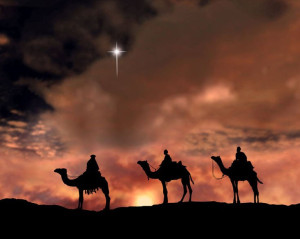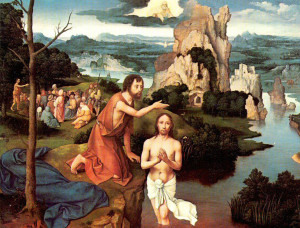With this observance of Epiphany, we bring to a close the fourth year of these celebration postings of Christ and Claus.
The observance had its origins in the Eastern Christian Churches and was a general celebration of the manifestation of the Incarnation of Jesus Christ. It included the commemoration of his birth; the visit of the Magi all of Jesus’ childhood events, up to and including his baptism in the Jordan by John the Baptist; and even the miracle at the wedding at Cana in Galilee. It seems fairly clear that the Baptism was the primary event being commemorated.
 Christians fixed the date of the feast on January 6 quite early in their history. Ancient liturgies noted Illuminatio, Manifestatio, Declaratio (Illumination, Manifestation, Declaration); cf. Matthew 3:13–17; Luke 3:22; and John 2:1–11; where the Baptism and the Marriage at Cana were dwelt upon. Western Christians have traditionally emphasized the “Revelation to the Gentiles” mentioned in Luke, where the term Gentile means all non-Jewish peoples. The Biblical Magi, who represented the non-Jewish peoples of the world, paid homage to the infant Jesus in stark contrast to Herod the Great (King of Judea), who sought to kill him. In this event, Christian writers also inferred a revelation to the Children of Israel. Saint John Chrysostom identified the significance of the meeting between the Magi and Herod’s court: “The star had been hidden from them so that, on finding themselves without their guide, they would have no alternative but to consult the Jews. In this way, the birth of Jesus would be made known to all.”
Christians fixed the date of the feast on January 6 quite early in their history. Ancient liturgies noted Illuminatio, Manifestatio, Declaratio (Illumination, Manifestation, Declaration); cf. Matthew 3:13–17; Luke 3:22; and John 2:1–11; where the Baptism and the Marriage at Cana were dwelt upon. Western Christians have traditionally emphasized the “Revelation to the Gentiles” mentioned in Luke, where the term Gentile means all non-Jewish peoples. The Biblical Magi, who represented the non-Jewish peoples of the world, paid homage to the infant Jesus in stark contrast to Herod the Great (King of Judea), who sought to kill him. In this event, Christian writers also inferred a revelation to the Children of Israel. Saint John Chrysostom identified the significance of the meeting between the Magi and Herod’s court: “The star had been hidden from them so that, on finding themselves without their guide, they would have no alternative but to consult the Jews. In this way, the birth of Jesus would be made known to all.”
 The earliest reference to Epiphany as a Christian feast was in A.D. 361, by Ammianus Marcellinus. St. Epiphanius says that January 6 is hemera genethlion toutestin epiphanion (Christ’s “Birthday; that is, His Epiphany”). He also asserts that the Miracle at Cana occurred on the same calendar day. In 385, the pilgrim Egeria (also known as Silvia) described a celebration in Jerusalem and Bethlehem, which she called “Epiphany” (epiphania) that commemorated the Nativity of Christ. Even at this early date, there was an octave associated with the feast.
The earliest reference to Epiphany as a Christian feast was in A.D. 361, by Ammianus Marcellinus. St. Epiphanius says that January 6 is hemera genethlion toutestin epiphanion (Christ’s “Birthday; that is, His Epiphany”). He also asserts that the Miracle at Cana occurred on the same calendar day. In 385, the pilgrim Egeria (also known as Silvia) described a celebration in Jerusalem and Bethlehem, which she called “Epiphany” (epiphania) that commemorated the Nativity of Christ. Even at this early date, there was an octave associated with the feast.
 In a sermon delivered on 25 December 380, St. Gregory of Nazianzus referred to the day as ta theophania (“the Theophany”, an alternative name for Epiphany), saying expressly that it is a day commemorating he hagia tou Christou gennesis (“the holy nativity of Christ”) and told his listeners that they would soon be celebrating the baptism of Christ. Then, on January 6 and 7, he preached two more sermons, wherein he declared that the celebration of the birth of Christ and the visitation of the Magi had already taken place and that they would now commemorate his Baptism. At this time, a celebration of the two events was beginning to be observed on separate occasions, at least in Cappadocia.
In a sermon delivered on 25 December 380, St. Gregory of Nazianzus referred to the day as ta theophania (“the Theophany”, an alternative name for Epiphany), saying expressly that it is a day commemorating he hagia tou Christou gennesis (“the holy nativity of Christ”) and told his listeners that they would soon be celebrating the baptism of Christ. Then, on January 6 and 7, he preached two more sermons, wherein he declared that the celebration of the birth of Christ and the visitation of the Magi had already taken place and that they would now commemorate his Baptism. At this time, a celebration of the two events was beginning to be observed on separate occasions, at least in Cappadocia.
 Saint John Cassian says that even in his time (beginning of the 5th century), the Egyptian monasteries celebrated the Nativity and Baptism together on January 6. The Armenian Apostolic Church continues to celebrate January 6 as the only commemoration of the Nativity.
Saint John Cassian says that even in his time (beginning of the 5th century), the Egyptian monasteries celebrated the Nativity and Baptism together on January 6. The Armenian Apostolic Church continues to celebrate January 6 as the only commemoration of the Nativity.
This description and its references can be found on Wikipedia.
Until Christmastime 2018 arrives may Christ consciousness become a growing aspect of your being and the joy of Claus gift giving be with you in all your comings and goings.
Advertisements Share this:- More





